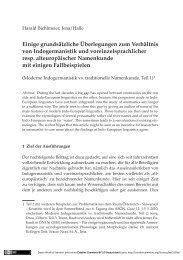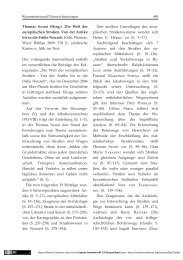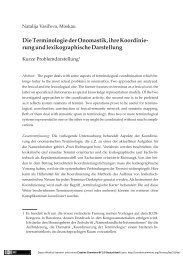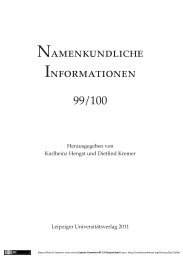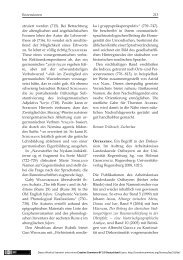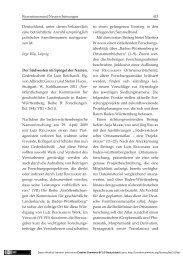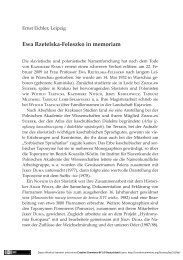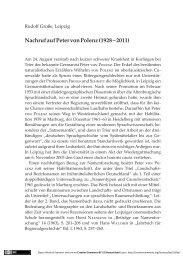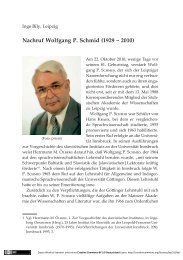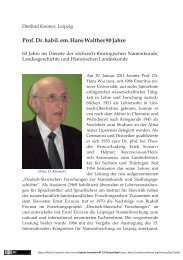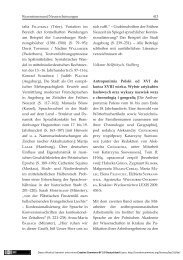Proper Names in the Light of Theoretical Onomastics
Proper Names in the Light of Theoretical Onomastics
Proper Names in the Light of Theoretical Onomastics
Create successful ePaper yourself
Turn your PDF publications into a flip-book with our unique Google optimized e-Paper software.
<strong>Proper</strong> <strong>Names</strong> In <strong>the</strong> <strong>Light</strong> <strong>of</strong> <strong>Theoretical</strong> <strong>Onomastics</strong>101a less precise expression <strong>of</strong> <strong>the</strong> same phenomenon. The explicit referenceto a class <strong>of</strong> onymic phenomena with<strong>in</strong> which an <strong>in</strong>dividual is identified<strong>in</strong> reference and <strong>in</strong> contrast to o<strong>the</strong>r <strong>in</strong>dividuals <strong>of</strong> <strong>the</strong> same class (and<strong>the</strong>oretically to o<strong>the</strong>r classes) does not have a negligible cognitive significance.A certa<strong>in</strong> onymic class (sub-system) is implicitly <strong>in</strong>volved whosenam<strong>in</strong>g elements have a content different from <strong>the</strong> homophonic names <strong>of</strong>o<strong>the</strong>r onymic classes (sub-systems). For example, <strong>in</strong> <strong>the</strong> nam<strong>in</strong>g <strong>of</strong> persons,a new fact is to be taken <strong>in</strong>to account. In many situations <strong>in</strong> communication,a person A1 is named also as a member <strong>of</strong> a certa<strong>in</strong> k<strong>in</strong>ship. At <strong>the</strong>level <strong>of</strong> <strong>the</strong> system, this is a feature <strong>of</strong> 〈± family affiliation〉 which is <strong>the</strong>area “specifically onomastic ”: This is to be discussed fur<strong>the</strong>r <strong>in</strong> <strong>the</strong> text.Us<strong>in</strong>g <strong>the</strong> form Mart<strong>in</strong> as an example, let us compare onymic objectswith <strong>the</strong> proprial sphere <strong>of</strong> s<strong>in</strong>gulative nam<strong>in</strong>g.The toponym Mart<strong>in</strong> is a s<strong>in</strong>gulative (s<strong>in</strong>gle-denotated) name <strong>of</strong> a town<strong>in</strong> <strong>the</strong> Turiec region. A common, specifically onymic element <strong>of</strong> <strong>the</strong> content<strong>of</strong> toponyms is <strong>the</strong>ir relatively close l<strong>in</strong>k with <strong>the</strong> location <strong>of</strong> an onymicobject 〈 location feature〉. Geographical names have strong local and timedimensions. The distribution <strong>of</strong> geographical names <strong>in</strong> a terra<strong>in</strong> representsa toponymic context (Karpenko 1967, 4).The form Mart<strong>in</strong> can also be a first name and a surname. For <strong>the</strong> class <strong>of</strong>persons, classification by <strong>the</strong>ir social and family membership is characteristic.Unlike <strong>the</strong> surname, <strong>the</strong> features <strong>of</strong> 〈family affiliation〉 and 〈 heredity〉at a negative stage are applied to <strong>the</strong> first name. (On Mart<strong>in</strong> as surname,see text below).The lexeme Mart<strong>in</strong> is also used as a name <strong>of</strong> a historical description <strong>of</strong>this town. In this case, it stands for a chrematonym which characterises<strong>the</strong> l<strong>in</strong>ks with <strong>the</strong> economic, productive and cultural activity <strong>of</strong> a man.name only partially co<strong>in</strong>cide with <strong>the</strong> views <strong>of</strong> experts <strong>in</strong> l<strong>in</strong>guistics and onomastics.The reason lies <strong>in</strong> <strong>the</strong> different aim <strong>of</strong> <strong>the</strong>ir research and different aspects <strong>of</strong> research.Logicians and philosophers analyse <strong>the</strong> proper name <strong>in</strong> isolation and not as a component<strong>of</strong> an onymic system. The second reason is <strong>the</strong> differ<strong>in</strong>g def<strong>in</strong>ition <strong>of</strong> <strong>the</strong> aims <strong>of</strong><strong>the</strong> research; proper names as <strong>in</strong>volved <strong>in</strong> onomastics and logic differ (see e. g. Zouhar2004). To our understand<strong>in</strong>g, proper names have <strong>the</strong>ir onymic semantics formed byseveral specifically onymic features (not just <strong>the</strong> “rigid designator” as used by Kripke).The basic elements <strong>of</strong> onymic systems have model values which also differ with<strong>in</strong> oneonymic system by <strong>the</strong>ir frequency and area distribution. In language communication,proper names fulfil a role <strong>of</strong> identification and differentiation. The analysis <strong>of</strong> isolatedproper names, whatever aspect we use, does not make for understand<strong>in</strong>g <strong>of</strong> <strong>the</strong>ir basiccharacter.



